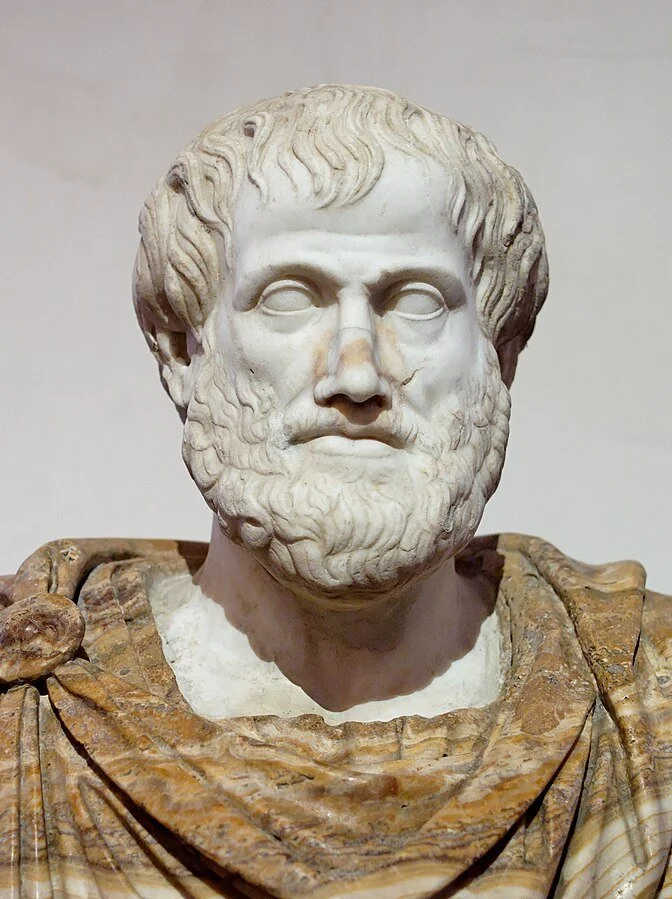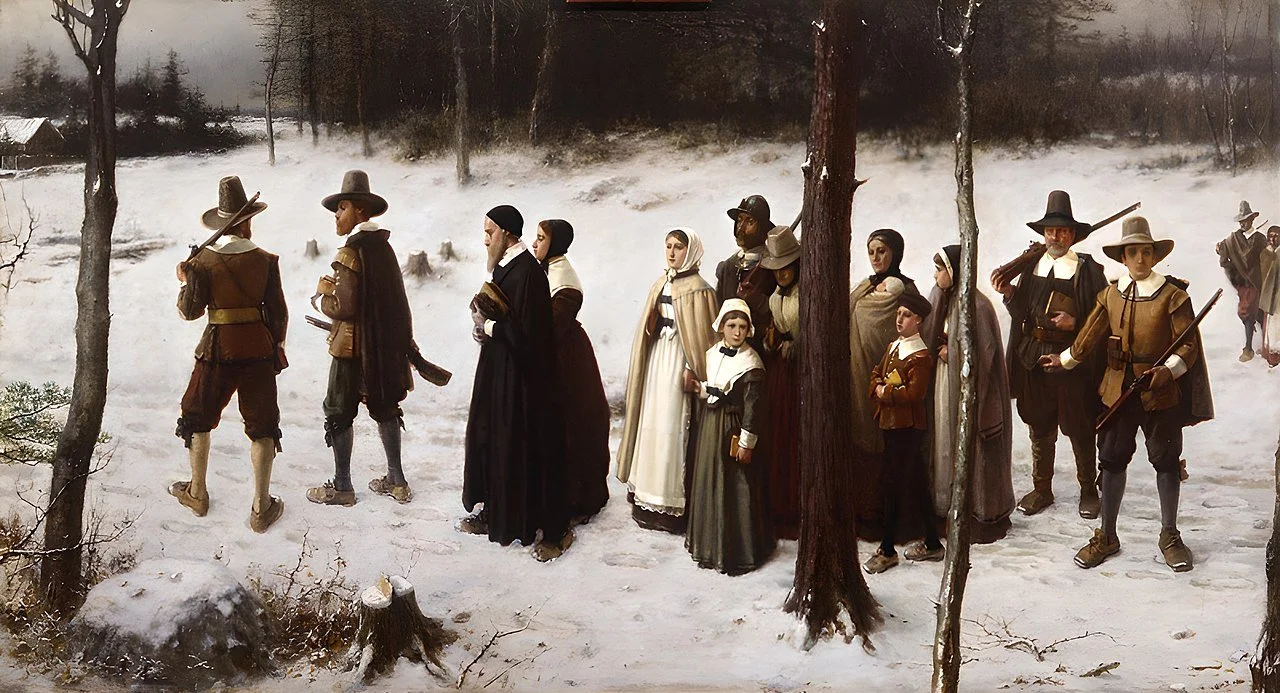1630: Western Notions of the “Black Race”
Big Idea
The enslavement of African men and women in the American colonies was supported by Western thought and religious interpretation, which portrayed Black people as inferior to White people and cursed by God. As Western views drove justification for enslavement, African men and women resisted dehumanization and asserted their humanity, dignity, and rights.
What’s important to know?
The Ancient Roots of Racism: Ideas of the inferiority of Black people to White people in Western history had surfaced as early as the ancient Greek times through Plato’s teachings.
Religion & Racism: The Puritans in New England were influenced by Plato and interpreted the Bible to support the view of Black people as inferior to White people.
African Resistance: Enslaved Africans actively resisted the enslavement and fought for their human rights.
Bust of Aristotle
Image Source: Wikipedia
1: The Ancient Roots of Racism
The growth of Black enslavement represented more than an opportunistic move on the part of White farmers. The shift from using poor White laborers as indentured servants to enslaved Black laborers was made easier because of deeply entrenched Western ideas that perceived Black people as inferior to White (Kendi, 2017, p. 17).
Distrust of Black people was reinforced by Puritan preachers in the New England colonies who had “learned rationales for human hierarchy [from Aristotle] and … began to believe that some groups were superior to other groups… Puritans believed they were superior to Native Americans, the African people, and even Anglicans—that is all non-Puritans” (Kendi, 2017, p. 17).
2: Religion & Racism
Pilgrims Going To Church
Painting by George Henry Boughton.
Image Source: Wikipedia
Puritan preachers in the Northern colonies argued that racial hierarchy was “biblical.” As evidence, they cited the story in the first book of the Bible where Noah cursed his son Ham and developed dark or Black skin (the assumption being that Noah was White).
The reasoning shared by influential preachers went something like this: “[T]he Negroes were the children of Ham, the son of Noah, and … they were singled out to be black as the result of Noah’s curse, which produced Ham’s colour and the slavery God inflicted upon his descendants” (Kendi, 2017, p. 21).
The “curse theory,” as it was known, validated the existence of a God-ordained hierarchy between the races. In their thinking, the White race represented the chosen leaders of mankind and the Black race represented those cursed and inferior.
Definitions
It is important to clarify the difference between human rights and civil rights. Many people are more familiar with the twentieth century civil rights movement and so can easily forget that the first fight for Black people in North America, was the fight for human rights.
What are human rights? The United Nations Human Rights Office of the High Commissioner defines human rights as:
“Human rights are rights we have simply because we exist as human beings - they are not granted by any state. These universal rights are inherent to us all, regardless of nationality, sex, national or ethnic origin, color, religion, language, or any other status. They range from the most fundamental - the right to life - to those that make life worth living, such as the rights to food, education, work, health, and liberty.”
Visit their website to read more about the Universal Declaration of Human Rights first adopted by the United Nations in 1948.
3: African Resistance
The Burning of Jamestown by Howard Pyle
Image Source: Wikipedia
It is important to remember that even as White plantation farmers justified the dehumanizing enslavement of Black people, African men and women retained their dignity and humanity. As historian Ella Forbes (1990) wrote, “The struggle belonged, after all, to Africans, and they accepted the obligation to wrest their freedom from those who benefited from their subjugation” (210).
One of the more well-known acts of resistance occurred in 1676 with Bacon’s Rebellion - an uprising that included White and Black indentured servants, slaves, and lower class White people. This diverse cross section of people rose up against the governor of Virginia and set fire to the Jamestown settlement. Their organizer, a wealthy White landowner who organized the rebellion to enact judgement against his British contemporaries for allying themselves with Native American tribes, was by no means in support of Black freedom. But, in this as with so many other episodes, regardless of the cause of the rebellion, “the multiracial alliance of landless freedman, servants, and slaves who carried it on had their minds set on freedom” (McGhee, 2021, p. 52).
Students
Want to know more? Watch the PBS video on the origins of race and racism in the United States.
PBS vide on “What is the origin of race?”
Think about It!
The Unrecognized Legacy
Lerone Bennett, Jr.
Image Source: National Archives
When retelling the history of the enslavement of African people, White historians often focus on what White people did to Black people, reinforcing a view of Black passivity, which suggests a lesser status. Read this excerpt from Lerone Bennett, Jr. (1975) from his book, The Shaping of Black America, as he writes about the gifts Black people have given to America, making it the country it is today.
“No one knows the hour or the day of the black landing. But there is not the slightest doubt about the month. John Rolfe, who betrayed Pocahontas and experimented with tobacco leaves, was there; and he said, in a letter to his superior, that the ship arrived ‘about the latter end of August’ in 1619. Rolfe had a nose for nicotine, but he was obviously deficient in historical matters, for he added gratuitously that the ship ‘brought not anything but 20 and odd Negroes.’ Concerning which the most charitable thing to say is that John Rolfe was probably pulling his superior’s leg. For in the context of the meaning of America, it can be said without exaggeration that no ship ever called at an American port with a more important cargo. In the hold of that ship, in a manner of speaking, was the whole gorgeous panorama of black America, was jazz and the spirituals and the Funky Broadway. Bird was there and Bigger and Malcom and millions of other X’s and crosses, along with Mahalia singing, Gwendolyn Brooks rhyming, Duke Ellington composing, James Brown grunting, Paul Robeson emoting, and Sidney Poitier walking. It was all there in embryo in the 160-ton ship.
The ship that sailed up the James on a day we will never know was the beginning of America, and, if we are not careful, the end. That ship brought the black gold that made capitalism possible in America; it brought slave-built Monticello and slave-built Mount Vernon and the Cotton Kingdom and the graves on the slopes of Gettysburg. It was all there, illegible and inevitable, on that August day. That ship brought the blues to America, it brought soul, and a man with eyes would have seen it, would have said that the seeds of an Alcindor are here, would have announced that a King was coming and that a Du Bois would live and die, would have foretold agonies and pains and funerals, would have predicted four hundred years of Sundays and Saturday nights. A man with eyes, I say, would have seen all that in the twenty black seeds planted that day and in the bad faith of whiteness that would manure them. He would have seen it all, and he would have stood up and announced to his startled contemporaries that this ship heralds the beginning of the first Civil War and the second.”
Your Turn
What is the origin of race? How has this view impacted views of White and Black Americans throughout history? How have Black Americans formed the United States to be the country it is today?
-
Explore materials created by the National Museum of African American History & Culture about race and the enslavement of Black peoples.
Explore the website, “Race: The Power of an Illusion" to find resources explaining how the theory of race has uniquely influenced the United States.
Read: Roediger, D. R. (2008). How Race Survived U.S. History: From Settlement and Slavery to the Obama Phenomenon. Verso.
-
Explore materials created by the National Museum of African American History & Culture specifically for educators.
Explore lesson plans on the website, “Race: The Power of an Illusion."
Explore lesson supports developed by Project READY for teaching about race.
-
General Resources:
Read about how racist ideas influenced the treatment of Native Americans in St. Louis.
Read about the early intersection and dependence between ideas of race and religious practices.
Books & Articles:
Early, Jr. G. (1999). Ain’t But a Place: An Anthology of African American Writings About St. Louis. Missouri Historical Society.
Archives:
The State Historical Society of Missouri: Frontier and Pioneer Life Research Guide
Museums & Parks:
-
Bennett, Jr. , L. (1975). The Shaping of Black America. Johnson Publishing Company, Inc.
Forbes, E. (1990). African-American Resistance to Colonization. Journal of Black Studies, 21(2), 210–223. http://www.jstor.org/stable/2784474
Kelley, Robin D.G., interview about race from the website: Race: The Power of an Illusion. Accessed February 2025.
Kendi, I. X. and Blain, K. N. eds. Four Hundred Souls: A Community History of African America, 1619-2019. One World Press.
McGhee, H. 1674-1679: Bacon’s Rebellion. In Kendi, I. X. and Blain, K. N. eds. Four Hundred Souls: A Community History of African America, 1619-2019. One World Press.
Smedley, A. and Smedley, B. (2012). Race in North America: Origin and Evolution of a Worldview. Routledge.
Williams, H. (2022). Black Historians, Race, and the Historical Profession. From the online publication: Black Perspectives. Accessed February 2025.
-
Bennett, Jr. , L. (1975). The Shaping of Black America. Johnson Publishing Company, Inc.
Forbes, E. (1990). African-American Resistance to Colonization. Journal of Black Studies, 21(2), 210–223. http://www.jstor.org/stable/2784474
Kendi, I. (2017). Stamped from the beginning: The definitive history of racist ideas in America. Nation Books.
McGhee, H. 1674-1679: Bacon’s Rebellion. In Kendi, I. X. and Blain, K. N. eds. Four Hundred Souls: A Community History of African America, 1619-2019. One World Press.


